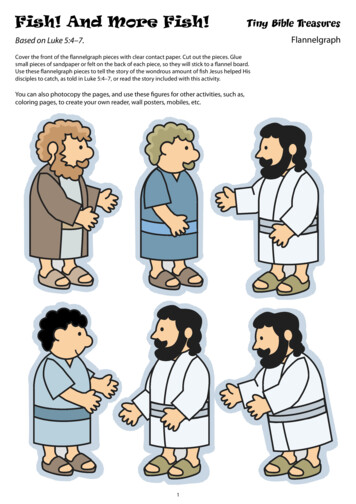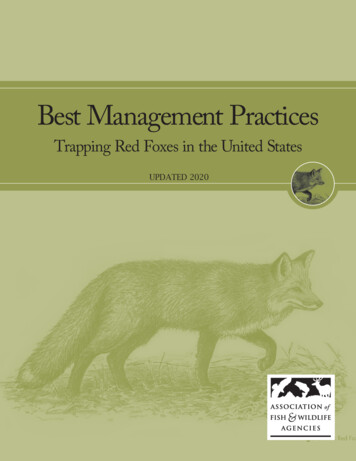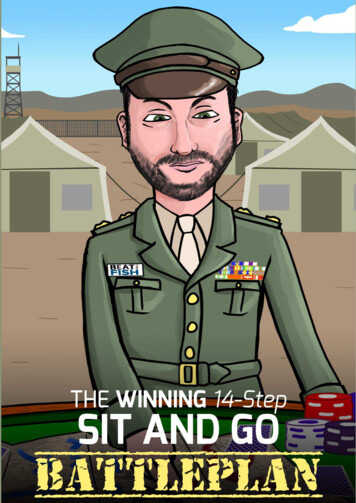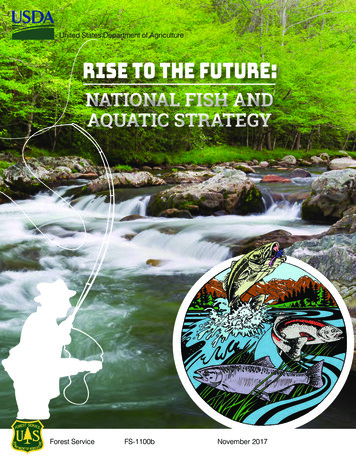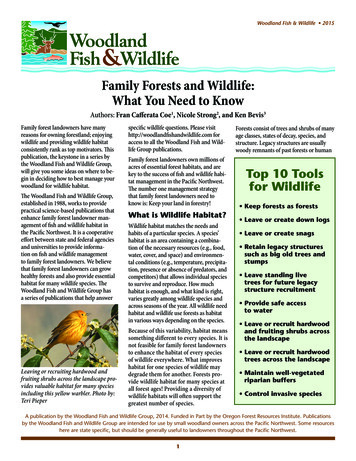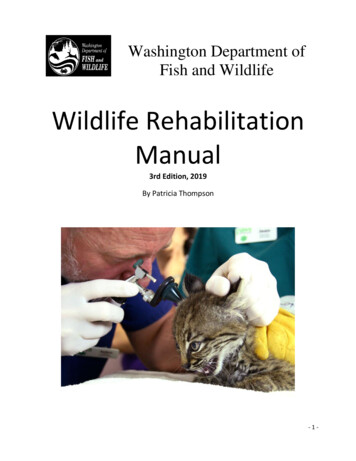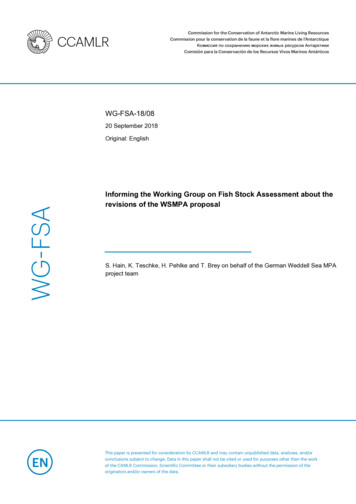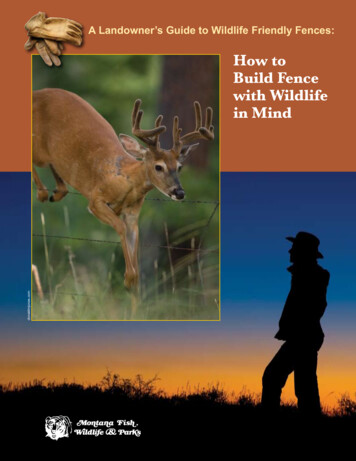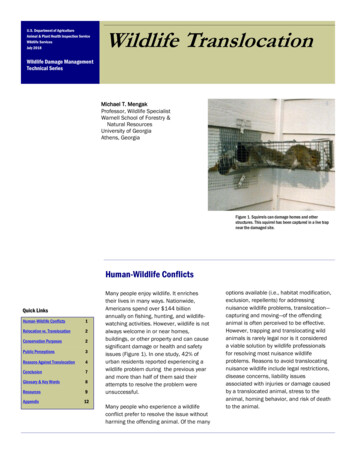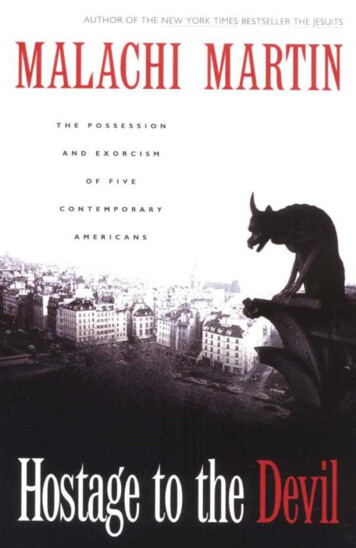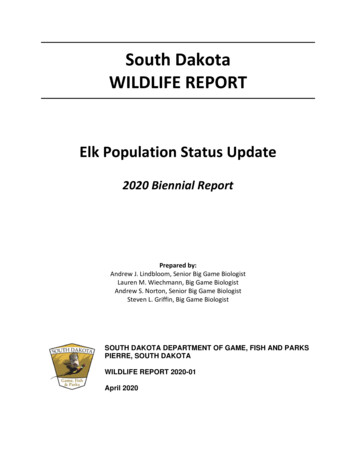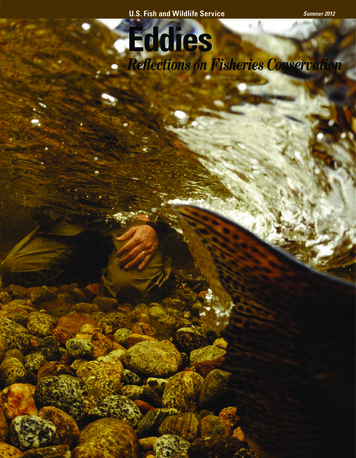
Transcription
U.S. Fish and Wildlife ServiceEddiesSummer 2012Reflections on Fisheries Conservation
DepartmentsEddiesVol. 5, No. eff Underwood, Assistant Director (Acting)U.S. Fish and Wildlife ServiceFisheries and Habitat ConservationSonar Reveals FishBehavior at anElectric Barrier–16PracticingMedicine–12Mark BrouderFrequent Eddies contributor, biologist Jeff Finley fromthe Columbia FWCO offers up two stories on some of thecommon tools used in conservation. You’ll know the “how”and “why” once you read Finley’s story.By Bryan ArroyoSean ConnollyEditorCraig SpringerKatie Steiger-Meister tells us about the FWCOslake sturgeon restoration on the Menomonee IndianReservation. The relationships between NativeAmericans and our Fisheries Program is crucial toconservation, and a proven model of cooperation, worthyof emulation elsewhere.Net Returns and OtherWays of CatchingFish–18Fish PeopleJeff Joley, Ph.D.–14Managing EditorRichard ChristianJeff FinleyTattoos and BodyPiercings–22Fish PeopleJohn Gill–15Jeff FinleyCraig SpringerThe Return of Name’–24Ashley Spratt andKatie Steiger-MeisterRichard Bach wrote, “A farewell is necessary beforeyou can meet again. And meeting again, after momentsor lifetimes, is certain for those who are friends.” Andas I write this, my last column as the Assistant Directorfor Fisheries and Habitat Conservation, I am excited tothink about the next time we will see each other. WhileAssistant Director, I met many of you. We crossedpaths at our great field facilities, at friends groupmeetings, and even on the water, fishing.Mark Brouder/USFWSAssistant Regional Directors – FisheriesMichael Carrier, Pacific RegionDan Castleberry, Pacific Southwest RegionJaime Geiger, Ph.D., Northeast RegionTim Jennings, Alaska RegionLinda Kelsey, Southeast RegionMike Oetker, Southwest RegionSharon Rose, Mountain–Prairie RegionTodd Turner, Midwest RegionContactFor subscriptions, visitwww.fws.gov/eddies, email craig springer@fws.govcall 505 248-6867, or write to:Craig SpringerUSFWS Fisheries RM 9100D500 Gold Ave. SWAlbuquerque, NM 87102Biologists from the Ashland Fish and Wildlife ConservationOffice release a lake sturgeon. Learn about the work of fishbiologists on page 12.DesignBlue HeronCommunicationsU.S. Fish and Wildlife ServiceEddiesHazel ArroyoDan MagnesonHenry QuinlanJohn RobinetteAshley SprattRandi Sue SmithKatie Steiger-MeisterStephanie VatalaroEditorial AdvisorsMark Brouder, U.S. Fish and Wildlife ServiceRyck Lydecker, Boat Owners Association of the United StatesMark Maskill, U.S. Fish and Wildlife ServiceHal Schramm, Ph.D., U.S. Geological SurveyMichael Smith, U.S. Fish and Wildlife Service (retired)Denise Wagner, U.S. Fish and Wildlife ServiceOn the Cover:Biologists practice catch and-release, too. Learnwhy on page 18.Tim Pask / Images On TheWildside photo.Until Next TimeCraig SpringerExecutive EditorMike WeimerContributing writersLee AllenKayla BarrettMark BrouderSean ConnollyBrian FillmoreJeff FinleyNorm HeilAbigail LynchHeadwatersAmerican Fishes 10Meanders30Summer 2012Reflections on Fisheries ConservationThe mission of the U.S. Fish and Wildlife Serviceis working with others to conserve, protect and enhance fish,wildlife, plants and their habitats for the continuing benefitof the American people.During my tenure, I visited the two oldest NationalFish Hatcheries in the U.S. in Neosho, Missouri andLeadville, Colorado. Although their histories date tothe 1880s, both facilities are beacons of promise for thefuture of aquatic species conservation in this country. Ihave every confidence in the expert hands of our fieldfolks, the partners they work with, and their scientificand technological capabilities.As we move into landscape level conservation itbecomes more evident that our Fish and WildlifeConservation Offices (FWCO) with their cadre ofdedicated professionals are the “trouble-shooters”for fisheries conservation challenges. Our FWCOshouse our conservation biologists at work, our on-theground practitioners who on a daily basis take on theseconservation issues.You’ll read about some of the work done by our FWCObiologists in this issue of Eddies. Mark Brouder fromthe Ashland FWCO contributes an analogy about howhis office and others like his are general practitioners,and fisheries are the patients. Brouder’s shop is steepedin coaster brook trout and lake sturgeon conservation.C O N S E RV I N GYou may know from reading past “Headwaters” that Igrew up in Puerto Rico and never need an excuse to fishmy home waters. Our “American Fishes” installment onredeye bass is an exhortation to visit home and fish thewaters of my youth, like Caonillas Lake. The story evokesan urge to pack my light spinning gear and hit the water.Perhaps I can share that story in a future issue of Eddies.Biologist Dan Magneson closes out this issue with acolorful piece titled “The Sundowner’s Club.” Magnesontouches upon the visceral of how people are connectedto the natural world, through the experience of fishingat night. Night fishing, I think I can say, changed hisperspective about his home waters. Differing perspectivesare a commodity and Magneson is probably the better forit.The Fisheries Program owns that commodity, too. That’sone of the characteristics that make our aquatic resourceconservation efforts so strong--diversity of thoughts andapproaches we use in solving problems. I learned veryearly in my tenure that no two fisheries facilities were thesame--nor should they be.So I leave you with a request. I encourage you, ifonly in moral support, to join our professionals intheir commitment to conserve America’s fisheries.Only working together at a landscape level will theconservation challenges be solved for the long-term,particularly as we face a threat of climate change.It has been an honor and privilege to serve asthe Assistant Director for Fisheries and HabitatConservation, and I close out a chapter in my journey. Asthe saying goes, “winds from the west, fish bite the best.”May you all have westerly winds in all your endeavors. FBryan Arroyo is the Assistant Director forInternational Affairs in Washington, DC.U.S. Fish & Wildlife Service2 EddiesSummer 2012Vol. 5, No. 2Reflections on Fisheries Conservation
WatermarksRunning Head TextRunning Head TextVeterinary medicine guides alligator snapping turtle conservationNew “Mother Nature’s Waterpark” ads draw families and friends toboating and fishingRBFF is focused ongrowing participationA new poster from the Recreational Boating & FishingFoundation evokes a classic look designed to get peopleon the water.Outdoor Enthusiasts—peoplewho enjoy boating and fishingwith crossover activities such ashiking and camping.Family Outdoors —those whoappreciate the outdoor activitiesas a family experience.Visit TakeMeFishing.org tolearn more about the campaignand Take Me Fishing’s keydigital assets such as its BoatRamp App, Fishopedia orPlaces to Boat & Fish Map. FStephanie Vatalaro4 EddiesAn alligator snapping turtle sets a threatening pose with its mouthagape.FEATURED FACILITYWarm Springs Fish Health CenterWhere: Warm Springs, GeorgiaWhen: Established 1989Then: Fish health biologists were stationed at PisgahForest National Fish Hatchery, North Carolina, andGreers Ferry National Fish Hatchery, Arkansas.The two labs serviced 10 southeast states and wereconsolidated at Warm Springs, Georgia, in 1989.Fisheries interns educate the next generationpursuing natural resourcesdegrees themselves,conduct field work, educateand engage Academyparticipants in theirwork, use social media todocument their experiences,and mentor what may bethe next generation ofconservation professionals.F Sean ConnollyUSFWSYouth Fisheries Academywas born in 2010 from astraightforward idea byWashington Fish and WildlifeOffice Fisheries technicianDan Spencer. Three summerslater, the week-long campshave now connected 452Washington State youthaged 7-18 each July to areastreams, biology and ecology,and natural resource careerpathways. Spencer runs theAcademy with the help ofsummer interns. The interns,Brian Fillmore/USFWSin boating and fishing as wellas generating awareness forthe conservation projects theysupport. The new ads extendthe campaign message to newaudiences. Research conductedboth before and during thenew campaign’s developmenthighlighted two groups thatcould be potential new boatersand anglers:The summer interns and students enjoyed a summerworking in Washington state.Summer 2012Now: Today, fish health biologists are part of theWarm Springs Regional Fisheries Center. The FishHealth Center (FHC) provides expertise in aquaticanimal health, including diagnostics, monitoring,investigations, certifications, and training relatedto both wild and captive populations. The FHCparticipates in the National Wild Fish Health Surveyand addresses emerging disease issues through appliedresearch and innovative management. Triploid (sterile)grass carp certification inspections are provided toprivate fish farmers in the Southeast. Biologists haverecently surveyed wild fish populations in Kentucky forVol. 5, No. 2USFWSRBFFCome outside and enjoy“Mother Nature’sWaterpark.” That’sthe message from theRecreational Boating& Fishing Foundation’s(RBFF) new Take MeFishing advertisingcampaign. Launched thisspring, the ads target thelikeliest next-generationand fastest-growingboating and fishingaudiences. Reminiscentof classic tourism andtheme park advertising,the ads are designedto inspire boating andfishing activities and toentice people to use theresources available onTakeMeFishing.org tohelp guide their day onthe water.You can’t tell the difference between juvenilemale and female alligator snapping turtles.The only non-lethal method to determinegender is with the use of a surgical laparoscopictechnique. Tishomingo National Fish Hatcheryin southern Oklahoma is currently assisting Dr.Day Ligon from Missouri State University andKay Backues, DVM, Director of Animal Healthof the Tulsa Zoo, in generating an age-specificdescription of juvenile alligator snapping turtlegender-identifying parts. Twelve turtles fromthree age classes were examined using high-techprocedures performed by Dr. Backues. Imagesof each turtle were captured and sex determinedby the presence or absence of egg follicles, whichresemble bubble wrap. Physical exams help todetermine the age at which turtles’ genitalia beginto show differences. The new techniques will allowhatchery biologists to stock known sex ratios ofalligator snapping turtles into the wild, furtheringthe conservation management of the species bystocking a proper sex ratio. F Brian FillmoreBiologist Brian Hickson conducts an assay to identifyfish viruses.Viral Hemorrhagic Septicemia, and for disease-causingpathogens on national wildlife refuges. Visit www.fws.gov/warmsprings/FishHealth. F Norm HeilReflections on Fisheries Conservation
Running Head TextRunning Head TextThis small wetland in Texas supports rare aquatic animals.Two endangered fishes—theComanche Springs pupfish andPecos gambusia—and three rareinvertebrates live in Phantom LakeSprings Ciénega, located in westTexas. These animals live in extremeStay or go – coaster brook trout6 Eddiesday, 7 days per week, wheneverthey might swim past a reader.Each PIT tag has a unique codeessentially giving individualfish a “name.” The dates andtimes that fish pass over readersare recorded on a computerfor retrieval at a later time. Todate, the Ashland FWCO hastagged over 3,000 brook troutand has helped deploy six PITtag stations across the LakeFish biologists insert a tag into the abdominalSuperior basin. A station setcavity of an anesthetized coaster brook troutat the mouth of Wisconsin’smeasuring 19 inches.Washington Creek has recordedsome telling numbers. OverSuperior before November. In the60 percent of coaster brook troutend, the data will be immense andtagged near Isle Royal Nationalshould reveal much about the dailyPark are swimming up the creek inand seasonal patterns of an importantSeptember and October to spawn.sport fish over a large area. FThey then move back out to LakeHenry QuinlanUSFWSAshland Fish and WildlifeConservation Office (FWCO)biologists and its partners continueto track the movement of stockedand wild-caught coaster brooktrout into and out of several LakeSuperior tributaries in Wisconsin andMichigan to better understand theirmigratory behavior and movementpatterns. Biologists first insertedpassive integrated transponders, orPIT tags, into the abdominal cavityof brook trout handled during annualsurveys. The tag, when passed overa reader, will record the movementof the tag and the fish carrying. Suchreaders, powered by solar energy,were installed at the mouths ofstreams pouring into Lake Superior.The movements of coaster brooktrout can be recorded 24 hours aSummer 2012Restoring American chestnut trees at Erwin National Fish HatcheryJohn Robinette/USFWSconditions due to a springflow decline since the 1940s,coupled with short-termfailures of pumps thatwere installed in 2001.With funding through theU.S. Fish and WildlifeService; Desert FishHabitat Partnership; U.S.Bureau of Reclamation; andTexas Parks and WildlifeDepartment, a new ciénega(Spanish for “marsh”) wascreated, the existing poolmodified to slow leakingof water through a cavewall, and a new pumpingsystem was installed. Thelined pool created a larger,more reliable habitat thatacts as a refuge, providesspawning and cover habitat,and maintains water levelsfor longer periods of time.This ciénega now hasmore habitats, increasingpopulations of the aquaticspecies that swim there. FKayla BarrettErwin National FishHatchery, Tennessee,in cooperation withVirginia PolytechnicInstitute and StateUniversity, has planted55 pure Americanchestnut trees on thehatchery’s grounds overthe last four years. Anadditional 10 trees peryear will be plantedin an effort to restorethis species to thesouthern AppalachianMountains. To date,36 of the 55 trees havesurvived, and survivalto maturity is expectedto be about 15 percent.Billions of Americanchestnut trees were lostduring the blight infestationfrom 1900 through 1940.Many cooperators haveplanted the seed providedby Virginia Tech, and inthe future, the formerlyabundant Americanchestnut may be a commonsight in the Appalachianlandscape. F John RobinetteOnce gone from the Appalachian Mountains,American chestnut trees are making a comback at aNational Fish Hatchery.FROM THE ATTICNotes from D.C. Booth HistoricNational Fish Hatchery and ArchivesIn 141 years of U.S. Fish and Wildlife Service history,a great deal of art has been created to communicateconservation. Some of it has made its way into theArchives at D.C. Booth. Of special importance this yearis the art of Bob Hines.Hines was hired by the Service in 1948 as an artist,a somewhat unusual occupation for a conservationagency—almost as rare as a Museum Curator! Over hiscareer he produced countless illustrations in variousmedia. Some of his most striking images include thefishes used in the 1971 book Sport Fishing USA thatcelebrated the centennial of the Service. Twelve of the22 paintings live in the collection at D.C. Booth. Thelocations of his other fish paintings are lost, locationsunknown.Hines kept fish in a large aquarium in his office forstudy, to aid in accuracy. This year, in honor of the 100thVol. 5, No. 2Craig Springer/USFWSUSFWSPhantom Lake Springs Ciénega wetter and betterThis close-up of a Yellowstone cutthroat trout paintingshows the detailed work of artist Bob Hines.birthday of Hines, three of the fish along with twobird drawings and his famous bald eagle painting, ASymbol of the Nation, are on display in our museum.To learn more about Hines or the Archives, contactRandi Smith, Curator, randi smith@fws.gov 605-642 7730, ext. 215.F Randi Sue SmithReflections on Fisheries Conservation
PioneersBy Lee AllenSeth GreenUSFWSTaught the habits of fish by SenecaIndians, Green’s initial scientificvoyeurism near the Genesee Gorge inupstate New York prompted furtherfishy observations and experimentswhich years later brought him fameand fortune as the acknowledged“Father of Fish Culture.”Seth Green isconsidered thefather of fish culture.Techniques hepioneered in the 19thCentury are useful infisheries conservationtoday.8 EddiesNearly two centuries ago, a youngfisherman named Seth Green—fascinated by the sight of salmonpreparing nests for spawning—climbed a tree overlooking the riverand remained perched there for twodays observing mating movements.He took note that as soon as femalescast their spawn, others rushed into feast on the roe. Observing thatfemale fish hurried to cover theremaining eggs with gravel, he opinedthat it might be possible to hatchfish artificially and “thereupon heresolved that sometime in the futurehe would try it,” according to a familyscrapbook begun in 1874.“Early observations of wild spawningsalmon led him to believe artificialpropagation and rearing of troutspecies could be done by man,”according to Carlos Martinez, directorof the D.C. Booth Historic NationalFish Hatchery & Archives, Spearfish,South Dakota. “After acquiring ahatchery site at Caledonia, NewYork, he began experiments whichultimately resulted in developmentof fundamental hatchery methodsand mechanisms still in use today.”For his perspicacity, Green is nowenshrined in the Fish Culture Hallof Fame located at the Spearfishfacility, as one of 50 persons whohave made significant contributionsto the advancement of fish culture.Travelers cruising Interstate 90near South Dakota’s Black Hills willdiscover additional accolades in thehall, a replica building of an 1899 icehouse on the grounds of the historichatchery.Green’s interest in all things fishybegan at an early age absorbing whathis indigenous playmates taughthim—how to observe and respond tothe sights, sounds, and meanings ofoutdoor nuance. He became an expertat fishing, inventing ingenious ways ofcatching fish by accounting for time ofyear, condition of wind and water, andspawning seasons. When his parentssuffered a financial reverse in 1837,Summer 2012the then 20-year-old Seth realized hewas now his own provider and since hewas fond of fishing, he set out to catcha lot of them—salmon in scoop nets,fat catfish on night lines, sturgeon upto 150 pounds taken by hook or byspear.apparatus as well as wooden tankswith natural-flowing waters.By the time he was 40, the fishmarket business was booming withone hundred workers in his employ,catching and selling a daily haulbetween one-half and three tons.Green frequently joined catch effortsand became known as one of thegreatest fishermen in New York.As a successful fish culturist, Greendeveloped a method of transportingfish eggs overland. He turned hisattention to raising new species,and published Trout Culture, FishHatching and Fish Catching, andHome Fishing in Home Waters.The art of artificial fertilization is, atleast conceptually, simple: strip thefemale of eggs, allow eggs to fall intoa pan where they are covered by themale’s milt, and immediately placedAccording to archival data: “Heon hatching beds under a constantkept busy skinning bullhead for thestream of water. It’s simple—butmorning market and as adept as heineffective, since only one quarter ofhad become, prepared two fish toeggs hatch. Through trial and error,the other fellow’s one.” Mindful ofGreen finally dispensed with waterdifficult financial times, Green fishedto mix spawn and milt and his firstcommercially for salmon, selling it atattempt at dry spawning hatched overfive cents a pound—and saving every 95 percent of the eggs—a fact thatcent he earned. He took a bride andhe kept secret for four years while hestarted a business—a fish market—by sold spawn and made money.the time he turned 30, positive eventsBut “It was neither money nor famethat still allowed time to carry on histhat he sought,” reports a historicalstudy of fish culture. And althoughpublication. “He was genuinelypeople thought him “acting queerlyinterested in restocki
U.S. Fish & Wildlife ServiceU.S. Fish & Wildlife Service his ofice and others like his are general practitioners, and isheries are the patients. Brouder’s shop is steeped . Bryan Arroyo is the Assistant Director for
